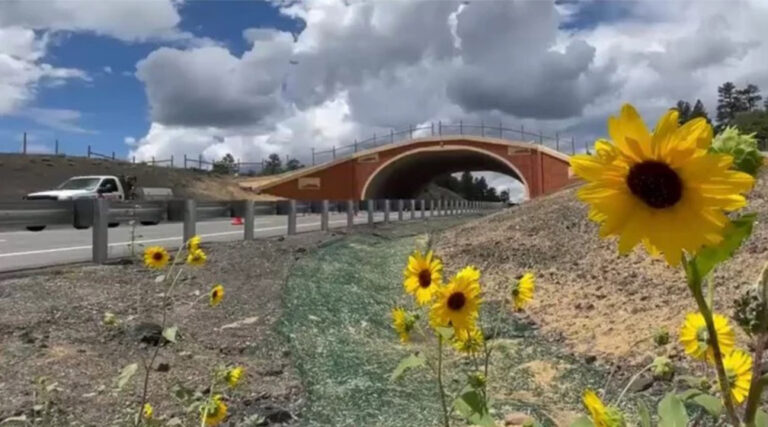RURAL COLORADO — The Colorado Department of Transportation (CDOT) recently completed the state’s newest wildlife overpass and underpass on U.S. Highway 160 between Durango and Pagosa Springs in southwest Colorado.
According to CDOT officials, the wildlife mitigation project will enhance safety for this section of the highway by promoting safer travel for motorists, enhancing the safer movement of wildlife and reducing wildlife-vehicle collisions.
CDOT recently hosted a ribbon-cutting celebration atop the wildlife arch over the highway.
“The event highlighted the benefits of the project and recognized the partnerships among government agencies, public organizations, nonprofit groups and private individuals that made the project possible,” according to a CDOT news release.
“This crossing not only improves safety for our state’s wildlife ― animals like mule deer, elk and bears ― but it secures protection for Coloradans in their vehicles,” said Marlon Reis, Colorado’s First Gentleman.
More than 60% of all crashes in the project area are attributed to wildlife-vehicle collisions, according to CDOT.
Without the mitigation treatment, these numbers were expected to grow as wildlife-vehicle crashes continue to show an increasing trend since 2012. The project’s wildlife safety features are expected to reduce those wildlife-vehicle collisions by 85%.
A busy highway can be a barrier to wildlife movement.
To help big game find their way across the road, a wildlife overpass was recently built over U.S. Highway 160 in southwest Colorado. The project also included an animal underpass, two miles of exclusion fencing, several earthen escape ramps, and a deer guard at the CO Highway 151 junction.
Gathering atop the wildlife overpass structure, the Southern Ute Bear Dance Chief offered a special blessing, the Southern Ute Singers drummed an honor song and government officials spoke, noting the significance and benefits of the highway safety project.
“Collaborative efforts have leveraged this and other wildlife mitigation projects in Colorado, making the construction of these highway features more feasible for CDOT,” the news release stated.
While many agencies and organizations come forward with project funding, other contributions from various entities may include resources like studies, research and development plans. For example, the Southern Ute Indian Tribe provided support with critical Global Positioning System data which identified seasonal migration patterns and habitat for mule deer and elk in the San Juan Basin area.
“Nineteen years ago, the tribe deployed its first set of GPS radio collars on mule deer. The results of those collars hinted at the importance of this particular spot and stretch (of roadway) as a migratory crossing point (for big game) on Highway 160,” said Aran Johnson, Southern Ute tribal wildlife biologist.

Partners involved in the U.S. 160 wildlife crossings project include:
- Colorado Department of Transportation ($9.458 million).
- Southern Ute Indian Tribe ($1.3 million, studies, and research).
- Colorado Parks and Wildlife ($750,000, studies, and research).
- National Fish and Wildlife Foundation ($317,000).
- Mule Deer Foundation ($100,000 via a private donor, in memory of Glen E. Grush, Bayfield, Colorado).
- Rocky Mountain Elk Foundation ($75,000).
- Federal Highway Administration (administration of federal aid & safety funding).
- Colorado Wildlife & Transportation Alliance (partnership & fundraising development).
Project Background
The construction project was awarded to Ralph L. Wadsworth Construction Co. of Utah. The total cost of the project is approximately $12 million, including design and planning. The two-season construction began in March 2021 and was completed in July 2022. Project features include:
- Wildlife underpass structure just west of the CO 151 intersection at MP 126.8.
- Wildlife overpass structure just east of the CO 151 intersection at MP 127.3.
- Two miles of 8-foot-tall exclusion fence along both sides of U.S. Hwy 160 from MP 126 – 128.
- Earthen escape ramps.
- A deer guard at the CO 151 junction.
- 8-foot-tall gates.
- The project also involved highway improvements of a new resurfacing treatment for two miles, an extension of the existing westbound passing lane on U.S. 160, and a new westbound left-turn acceleration lane, both on U.S. 160 to enhance intersection access onto and off of CO 151.
CDOT has built more than 60 wildlife mitigation structures crossing above or under highways throughout the state. Additionally, 400 miles of high big game fencing have been installed along state and U.S. highways or next to the interstates. The agency’s Planning and Environmental division continues to seek opportunities to incorporate wildlife mitigation features into future highway construction projects.
The Trucker News Staff produces engaging content for not only TheTrucker.com, but also The Trucker Newspaper, which has been serving the trucking industry for more than 30 years. With a focus on drivers, the Trucker News Staff aims to provide relevant, objective content pertaining to the trucking segment of the transportation industry. The Trucker News Staff is based in Little Rock, Arkansas.








